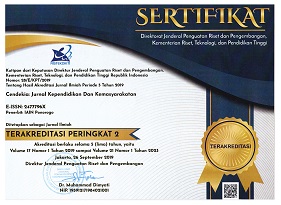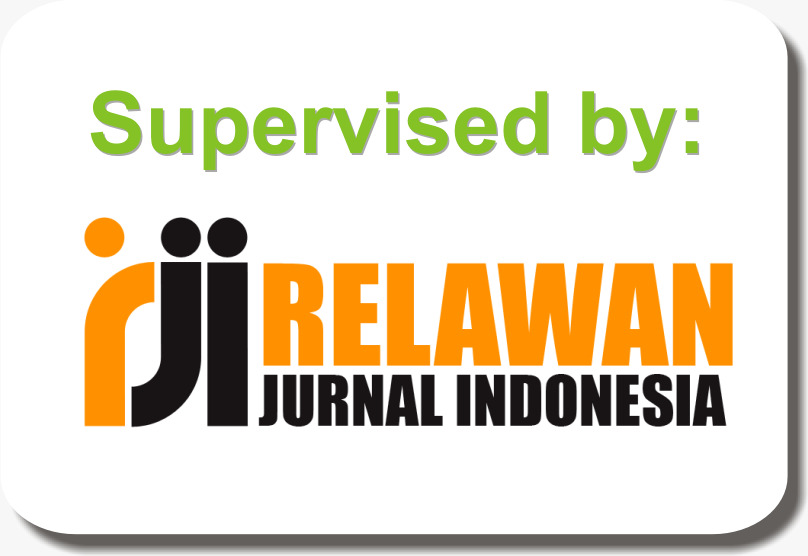Pattern Analysis of the Relationship Profile of Students’ Curiosity and Internalization-Interconnection of Qur’an and Science
DOI:
https://doi.org/10.21154/cendekia.v21i2.7263Kata Kunci:
curiosity, internalization-interconnection, Qur'an and scienceAbstrak
This study aims to analyze the profile of curiosity and the pattern of linkages of students' curiosity at all levels of Madrasah Ponorogo to the internalization-interconnection of science material with Qur'anic values. This research employed qualitative research with a naturalistic design. The sampling technique was carried out by purposive sampling of seven people spread across every level of education. Data were collected through interviews, observation, and documentation. Then the data was analysed through descriptive quantitative and qualitative. The results of the research on the curiosity profile of students at each level tend to be associated with events in the observed surroundings, develop according to experience and age, can internalize-interconnect the context of natural events with verses of the Qur'an when they have reached the stage of exploring (adventures) and the pattern of linkages between students' curiosity towards the internalization-interconnection of science material with Quranic values creates the ability for Spiritual-Scientific Accommodation due to stimulation in the form of incentives, attention, scientific dogma, and spiritual interpretation.Referensi
Ahmadi, Basuki, and Edi Irawan. “The Internalization of Attitude and Values: Comparison Study in PTKIN and PTKIS.” Cendekia: Jurnal Kependidikan Dan Kemasyarakatan 18, no. 1 (2020): 17”“32.
Creswell, John W., and Cheryl N. Poth. Qualitative Inquiry and Research Design: Choosing among Five Approaches. Sage publications, 2016.
Dewi, Noviana, and Purwati Purwati. “Menumbuhkan Karakter Ingin Tahu Pada Siswa Dengan Metode Pembelajaran Sains Kimia Tentang Bahan Tambahan Makanan.” In Prosiding Seminar Nasional Psikologi Unissula, 2018.
Fadly, Wirawan, and Fatkul Jannah. “Diagnostic Skill of Internalization-Interconnection Qur’ani With Science in Three Levels of Madrasah.” Cendekia: Jurnal Kependidikan Dan Kemasyarakatan 18, no. 2 (2020): 267”“89.
Fahyuni, E. F., W. Wasis, A. Bandono, and Moch Bahak Udin By Arifin. “Integrating Islamic Values and Science for Millennial Students’ Learning on Using Seamless Mobile Media.” Jurnal Pendidikan IPA Indonesia 9, no. 2 (2020): 231”“40.
Fraenkel, Jack R., Norman E. Wallen, and Helen H. Hyun, How To Design And Evaluate Research In Education 8th Ed. (New York: McGraw-Hill, 2012
Handoyo, L D, Paidi, and P Suparno. “Application of Service-Learning for Developing Curiosity, Responsibility, and Honesty of Biology Education’s Students, Sanata Dharma University.” In Journal of Physics: Conference Series, 1097:012040. IOP Publishing, 2018.
Higgins, Joanna, and Azra Moeed. “Fostering Curiosity in Science Classrooms: Inquiring into Practice Using Cogenerative Dialoguing.” Science Education International 28, no. 3 (2017): 190”“98.
Murtono. “Pendidikan Sains Dalam Al-Qur’an.” Jurnal Pendidikan Agama Islam II, no. 02 (2005): 163”“74.
Prahastiwi, Rima Buana. “Penerapan Pendekatan Saintifik Untuk Meningkatkan Karakter Rasa Ingin Tahu Dan Prestasi Belajar Siswa Kelas X MIA 3 SMA Negeri 6 Malang.” PhD Thesis, Universitas Negeri Malang, 2014.
Purwati, Nining, Siti Zubaidah, Aloysius Duran Corebima, and Susriyati Mahanal. “Increasing Islamic Junior High School Students Learning Outcomes through Integration of Science Learning and Islamic Values.” International Journal of Instruction 11, no. 4 (2018): 841”“54.
Puspitasari, Fantika. “The Integration-Interconnection Discourse of Islamic Education and Science in Indonesia.” Tarbawi: Jurnal Pendidikan Islam 2, no. 8 (2020): 153”“62.
Raharja, Steven, Martinus Ronny Wibhawa, and Samuel Lukas. “Mengukur Rasa Ingin Tahu Siswa.” Polyglot: Jurnal Ilmiah 14, no. 2 (2018): 151”“64.
Slavin, Robert E. Educational Psychology: Theory and Practice. Boston: Allyn and Bacon, 2019.
Solahudin, M. “Pendekatan Tekstual Dan Kontekstual Dalam Penafsiran Al-Quran.” Al-Bayan: Jurnal Studi Ilmu Al- Qur’an Dan Tafsir 1, no. 2 (December 30, 2016): 115”“30.
Sunarko, Asep. “Iptek Dalam Perspektif Al- Qur’an.” Manarul Qur’an 14, no. 1 (2015): 1”“14.
Titrek, Osman, and William W. Cobern. “Valuing Science: A Turkish-American Comparison.” International Journal of Science Education 33, no. 3 (2011): 401”“21.
Weible, Jennifer L., and Heather Toomey Zimmerman. “Science Curiosity in Learning Environments: Developing an Attitudinal Scale for Research in Schools, Homes, Museums, and the Community.” International Journal of Science Education 38, no. 8 (2016): 1235”“55.
Yasin, Ahmad Alfian Risydan, Aditya Marianti, and Ely Rudyatmi. “Kontribusi Tingkat Rasa Ingin Tahu Terhadap Kualitas Aktivitas Siswa Dalam Pembelajaran Respirasi Berbasis Pendekatan Saintifik.” Journal of Biology Education 6, no. 2 (2017): 195”“205.
Zulaekah, Siti, and Yuli Kusumawati. “Halal Dan Haram Makanan Dalam Islam.” Suhuf 17, no. 01 (2005): 25-35.
Unduhan
Diterbitkan
Cara Mengutip
Terbitan
Bagian
Lisensi
Hak Cipta (c) 2023 Wirawan Fadly

Artikel ini berlisensi Creative Commons Attribution-NonCommercial 4.0 International License.
Syarat yang harus dipenuhi oleh Penulis sebagai berikut:- Penulis menyimpan hak cipta dan memberikan jurnal hak penerbitan pertama naskah secara simultan dengan lisensi di bawah Creative Commons Attribution License yang mengizinkan orang lain untuk berbagi pekerjaan dengan sebuah pernyataan kepenulisan pekerjaan dan penerbitan awal di jurnal ini.
- Penulis bisa memasukkan ke dalam penyusunan kontraktual tambahan terpisah untuk distribusi non ekslusif versi kaya terbitan jurnal (contoh: mempostingnya ke repositori institusional atau menerbitkannya dalam sebuah buku), dengan pengakuan penerbitan awalnya di jurnal ini.
- Penulis diizinkan dan didorong untuk mem-posting karya mereka online (contoh: di repositori institusional atau di website mereka) sebelum dan selama proses penyerahan, karena dapat mengarahkan ke pertukaran produktif, seperti halnya sitiran yang lebih awal dan lebih hebat dari karya yang diterbitkan. (Lihat Efek Akses Terbuka).

This work is licensed under a Creative Commons Attribution-NonCommercial-ShareAlike 4.0 International License.
















